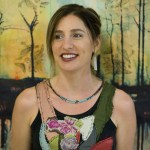
Emily Arthur
University of North Florida
earthur@unf.edu
www.emilyarthur.org
Biography
Emily Arthur is an Associate Professor, University of North Florida, with an MFA from Pennsylvania Academy of Fine Arts, USA. She has served as Artist in Residence, Vallauris, France; Venice International Print Studio and cultural exchange artist to Japan with educators from the Diné/Navajo Nation.
Arthur has received a grant from the state of Florida & National Endowment for the Arts and awarded to National Museum of Women in Arts. Collections include Denver Museum, Tweed Museum and international collections within Russia, Estonia, Japan, New Zealand, Iceland, United Kingdom, France, and has exhibited on the Occasion of the Venice Bienalle 54th.
Themed Panel Proposal
A Cherokee Story of Celtic Crossings
Emily Arthur, Associate Professor, University of North Florida, USA
Through the fine art of printmaking, this illustrated talk investigates connections between the indigenous Cherokee and the Highland Scot immigrant experiences of place and displacement, particularly in the century from 1739-1838, during which they shared land in the Blue Ridge Mountains of North Carolina and a relationship, which involved a reconfiguration of the land and their place within it.
The oral traditions of Scottish Celts and American Indian Cherokees express a shared relationship the natural world. I believe that story, songs and ceremony can be valued and preserved as a means to challenge the limited text based scholarship upheld in the western tradition of colonization.
The Highland Scots who immigrated to North Carolina and the Cherokee indigenous to North Carolina both share the changing experience of Home due to separation and forced relocation under 18th and 19th century conditions of war and colonization.
Highland Scotsmen migrated to North Carolina following their defeat against the English at the 1745 Battle of Culloden and the Highland Clearances, forcing many Scots to give up their land. Scots were encouraged to settle in North Carolina by a 1739 ten-year tax exemption.
For Cherokee people indigenous to North Carolina, President Jackson signed the Indian Removal Act of 1830, authorizing the removal of all Native Americans in the southern US to territory west of Mississippi River in exchange for their homelands, followed by 1838 Trail of Tears which forcibly removed the Cherokee people to the Indian Territories of present day Oklahoma.
In the 100 intervening years, Scots and Cherokee built a rich and troubled relationship with the North Carolina mountains that they called home. I seek to understand more of how each culture pushed outside of their indigenous boundary still carries part of a story unbroken from ancient lands despite generations of exile and forced relocation.
Exhibition
Crossing State Lines: A Survey of American Printmakers
Emily Arthur, Associate Professor, University of North Florida, USA and John
Hitchcock, Professor, University of Wisconsin-Madison, USA respectfully propose the exhibition of “Crossing State Lines: A Survey of American Printmakers,” during the Impact 8 Conference, Borders & Crossings. This proposed exhibition celebrates the widest possible selection of American artists, concepts and print practices including traditional, non traditional and digital/photographic techniques used in contemporary American lithography, etching, screen print, mezzotint and relief printmaking.
This exhibition of hand pulled, original, prints is created to promote the education
of printmaking techniques as they are continually recreated during the professional exploration of concept and practice in the artists’ print studio. Eightyfive artist-printmakers from the US were selected and collated by the “State of the States” portfolio constituency of print faculty from across the United States,
which are: Joseph Velasquez, University of Wisconsin-Stout, Nicole Hand Murray
State University, Kentucky, Ryan O’Malley Texas A & M University, Kathryn &
Andrew Polk, University of Arizona, Emily W. Arthur, University of North Florida,
John Hancock, University of Mary Hardin Baylor in Texas, Marwin Begaye &
Curtis Jones, University of Oklahoma, and John Hitchcock, University of
Wisconsin- Madison.
